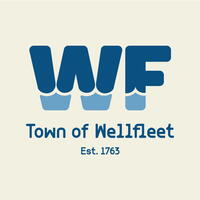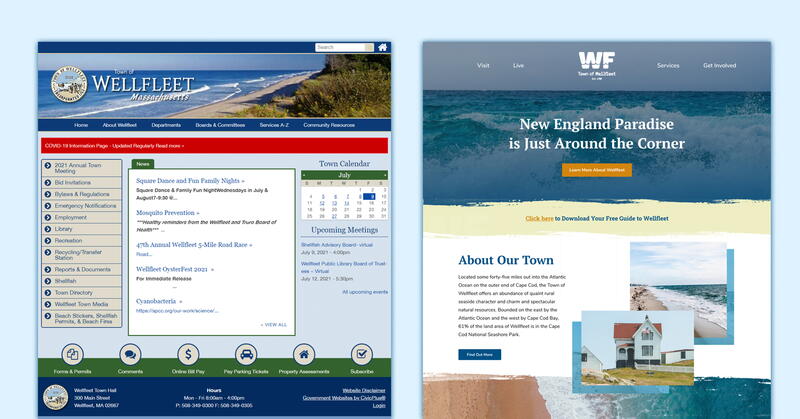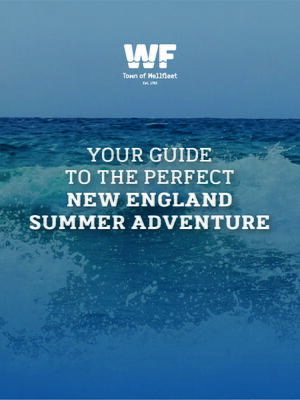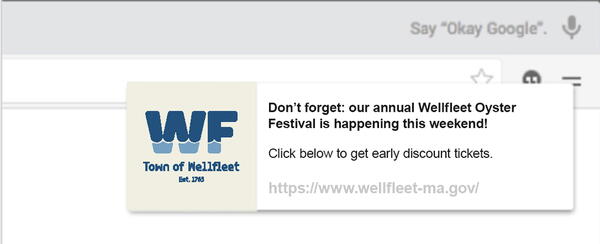
The COVID-19 pandemic changed the way we fundamentally view where we should live, work, and play. Take advantage of this unique moment in time to make your community a top-of-mind destination for working, raising a family, and vacationing by leveraging your brand and digital presences.
The Opportunity: How COVID-19 Changed Our Relationship to Physical Space
When COVID-19 swept the nation in March 2020, travel and movement came to a halt, as newscasters cycled through images of families stuck on cruise ships and in hotels and discussed the possible negative impacts of visiting public places, riding airplanes, and more. What followed was a devastating $645 billion of loss in the U.S. travel economy alone. That estimated sum is even more disheartening when we consider our personal experiences with the jobs lost in our communities, the closing of beloved small businesses around us, and the complete standstill that many of our towns and cities came to for months on end.
Now that we have a vaccine, travel confidence has increased dramatically: people are eager to get out and indulge in traveling and sightseeing. However, after a year of spending all of their time at home, many people are also reconsidering where they want to live, whether they want to work in an office building or from home, and what kind of lives they should lead in general.
With this seismic shift in how we live comes new expectations of how we interact with the world and physical space around us. Individuals who once lauded huge, expensive office buildings became enamored with remote work, which gave them more flexibility in their schedule and time with family. To boot, studies show that working from home led to an average 47 percent increase in productivity at companies that allowed employees to work from home. Many companies who would have never dreamed of going remote in 2019 are now implementing permanent protocols for full-time or blended office and work-from-home policies.
Why does this matter? Millions of individuals who once had to live in specific places to work (i.e., wildly expensive cities) are now free and open to living where they will be happiest.
Secondly, while the world was moving toward digital shopping and decision-making before the pandemic hit, COVID-19 accelerated that growth by multiple years. In 2020, e-commerce grew 44.5 percent year-over-year, or at the rate it was supposed to hit over a five-year period from 2019 to 2024. Yes, we are quite literally living in the digital future!
It should, thus, come as no surprise that when U.S. consumers are making decisions regarding traveling, moving, real estate, leisure, and the like, at least 91 percent will consult the internet first. The world as we know it has completely shifted.
What does this mean for our cities and towns? Digital branding and marketing are no longer just an option (or tasks to kick down the road for later). They are essential to gaining any market share from a majority of current consumers and for the generations to come.
How can you take advantage of or protect your city or town during this once-in-a-lifetime generational shift? The answer may lie in how you brand your city and get information about it out into the digital world. This article will cover the basics of putting a new brand into place and how digital can help drive economic recovery to your very own community.
Starting with the Basics: Essential Elements of Branding and How to Make Them Work for You
Brand Positioning
Let’s start off with the first question you should address when considering rebranding. What makes your special area of the country unique? Why should you want to work, play, or live there? For instance, Colorado is a great place to ski, while Hawaii has awesome surfing. My town might have stellar hospitals, while yours is a haven for artists. When you are outlining what differentiates your brand from others, consider which parts of the local economy are in the greatest need of recovery post-COVID-19. Making them a central part of your brand positioning can make all of the difference in garnering the results you’re looking for.
For example, if your town wants to attract young families to purchase homes in building developments that stagnated during COVID-19, make sure your brand exudes family friendliness and explains the benefits of raising children in your area.
Brand Voice
Now that you understand what makes your community different and what you are looking to achieve in the market, it’s time to define your brand voice and messaging. What kind of voice do you want your town to have when you write and speak about it? Is it laser-focused and “smart” to attract tech entrepreneurs? Is it fun and adventurous in an effort to showcase all of the wildlife your county has to offer? To illustrate, New York City’s “voice” exudes the promise of hustle, bustle, and opportunity, reflective of its huge multicultural population and booming economy.
Brand Audience and Messaging
Knowing your brand voice and the various characteristics of your community that make you stand out, create a thorough listing and description of the audiences you hope to reach. Classify them by age range, profession and income-level, interests and hobbies, and identify their wants and needs. Be realistic in the process: for example, Californians are much less likely to visit a town in Cape Cod than a family from Rhode Island, just like a family with a newborn probably won’t visit Las Vegas for a weekend of gambling.
Once you have your list of potential audiences and their demographics, create messaging that will resonate with each grouping. Prioritize the audience and messaging pairs in order to understand which are most important in driving economic recovery to your town. Make sure that even in the face of recovery, your messaging makes promises to your audience that you can deliver on. A successful brand’s longevity depends on keeping promises to consumers.
Brand Identity
Finally, the fun part that everyone attributes to branding: logos, colors, typography, slogans, and more! Now that you understand your audience and messaging, what kind of brand identity can you create to intrigue them? This is when you get to work on creating a tagline that encompasses your main selling point(s), a logo that accurately reflects your community, and associated graphics, coloring, and typography to use across all of your future marketing materials.
Branding and Marketing Materials
The most important branding and marketing material that you can invest in now is a modern, intuitive, and engaging website. The website is more than just an informational brochure: it is the central point of contact for all potential visitors and should leave a great impression. Your other channels—social media, email marketing, in-person signage, etc.—will all lead back to your website. All of the work you put into your brand positioning, voice, and messaging should be clearly and accurately depicted on your website.
Furthermore, each potential audience that will visit your website should have a clear and specific understanding of how to engage with your town or city. There should be an obvious place for tourists, residents, city workers, and whomever else is relevant to quickly find the information they need on your website.
Other materials that accompany a rebrand include the design and strategy for your social media platforms, email marketing strategy and templates, and traditional items like flyers, signage, letterheads, and cards.
Performance-Based Marketing: Driving Real Results with Your New Brand
You have a beautiful new brand that conveys everything you want: now what? Time to get the eyeballs of your intended audience on your new materials. Before we dive into what you should focus on next, let’s first debunk some myths about city/county marketing.
Marketing in 2021: The Problem with CPM and GRP
If you have ever worked on a campaign for your city or town, you have probably heard the word “impressions,” or the terms CPM (cost per thousand impressions) and/or GRP (gross rating point) thrown around.
An impression is simply a “view” of a piece of marketing or advertising content. And as its unabbreviated name suggests, CPM is a metric used to determine how much it costs to receive 1,000 impressions.
GRP first quantifies what percentage of your target market has seen, or been impressed upon, by your content. It is then multiplied by frequency. For example, if 40 percent of your target market saw your commercial two times, your GRP would be 80.
Impressions, CPM, and GRP were all the rage in the pre-internet era because they were our only option and hope for measuring the success of marketing and advertising campaigns. There was simply no way to track the costs of marketing while equating them to specific action.
As an example, commercials for beer were played during football games when many men were watching television, and advertisers hoped that if they saw the content multiple times, they would grab for Heineken instead of Coors Light at the grocery store. This is an imperfect science that leads to a lot of economic loss, especially if you are on a tight budget.
Driving Radical Results for Your Town or City: Metrics You Should Pay Attention to in 2021
Today, we have stunning alternatives to earlier models of impression marketing, but many people are still unaware of the advanced capabilities of digital marketing. Instead of “hoping” for results, only to be proven over the course of months or years as financial reports come in, organizations can now closely track actions and make real-time decisions about how to allocate their funds. Welcome to the world of performance marketing!
First off, you can precisely decide who you want to show marketing messaging to—the audience is completely in your control. Instead of using semantics, like the above example of “well, men watch football and hopefully they sit through commercials,” we can decide to place ads based on advanced targeting metrics via platforms like Facebook and Google.
Let’s say we want to drive the same population of men to a live football game to help regenerate a local economy. We can specifically target men who love football, who live in a specific radius, who buy tickets to local events, and have a certain income-level with our message. Now 100 percent of the people who are seeing your ad are actual members of your target audience. You know they love football, you know they can afford the ticket, and you know they live nearby and like going to events.
Secondly, and even more importantly, you can track cost based on specific actions the audience takes. For example, you can track the cost to turn one football fan from Facebook into a ticket-buyer. If it costs $15 in ad spend to get one person to buy two $50 tickets to the game on Sunday, you are in the green by $85. You can continue to invest $15 into ad spend to get as many new ticket purchases as you want!
Beyond that, depending on your goals, you can track all kinds of metrics: the cost to acquire an interested potential resident, the cost to have a potential tourist join your newsletter or download a guide to your city, the cost to acquire new lifeguards for your community center. The opportunities are endless.
What’s more, these digitally driven tactics can all scale up and down in a matter of moments. If the sports industry is getting a little too busy, you can reallocate your budget dollars in real time to bolster art tourism. Leveraging digital tools properly can be life-changing for your residents.
Other Platforms to Consider
Email Marketing and SMS
Only about one percent of new visitors to your website will return if left to their own devices. Depressing, but true! Luckily, email marketing and SMS strategies are an affordable and incredible way to keep your audience engaged.
It is, thus, crucial to ask visitors for their email address and/or cell phone number so that you can re-engage them, educate them about what your town has to offer, and ultimately, turn them into an active member of your community.
Many people think email is “dead” and that no one wants to hear from a city or town: this couldn’t be farther from the truth. People who register to hear from you will look forward to your messages and get into the habit of thinking about your brand regularly.
When the decision comes around on where to move, where to vacation, or what to do on Saturday night, your messaging will be top-of-mind. You can even customize what messages get sent to which audience segment so that someone who lives in town doesn’t get a message about the benefits of moving to your town. This level of specificity is another gift of the digital age.
Website Notifications
Another interesting way to keep people engaged with your community after they’ve visited your website is to ask them to opt-in for browser-based notifications. Each time you have exciting news or put out content, you can notify your audience through their browser, which will consistently bring them back to your groovy new website.
Case Study: Wellfleet, Massachusetts
We would be remiss not to include a high-level example of what a city or town rebrand might look like. Here is a step-by-step walkthrough of how we might approach rebranding the lovely New England coastal town of Wellfleet, Massachusetts.
Step 1. Brand Positioning, Voice, Audience, and Messaging
Located on Cape Cod, Wellfleet is a beautiful town that drew many visitors pre-COVID for its beaches, exquisite hiking trails, delicious oysters, and abundant wildlife sanctuary. Since tourism is such an important part of Wellfleet’s economy, a rebrand may focus on explaining to people why this is where their next vacation should be. The voice of the brand is calm, relaxing, and inviting, expressing the ease travelers will experience during their visit.
For the intended audience and messaging, we decided to focus our efforts on people looking for an easy escape to nature, beaches, and wildlife from nearby metropolitan hubs like Providence, Boston, Hartford, and New York City. The brand’s slogan, “New England paradise is just around the corner,” appeals to their desire for an easy-to-get-to idyllic escape from the hustle and bustle of city life.
Step 2. Brand Identity
Next we turn to establishing a new brand identity, logo, color scheme, typography, etc., to embody the brand. Before, Wellfleet’s logo was outdated, focused on the historical aspect of the town, and was not very enticing or clean.

Wellfleet’s new logo is modern, easy to recognize, and embodies the water and wildlife the town is known for.

Step 3. Branding and Marketing Materials
As mentioned earlier, the website is the absolute most important material to transform in the rebranding process. Here’s a quick look at how this might play out (see below): before (on the left side) and after (on the right side). The new navigation menu at the top of the site also makes it much easier for new visitors to find the information they need by selecting: Visit, Live, Services, or Get Involved. After taking a look at this comparison, which town do you want to visit?

On this website, we have also implemented a “lead magnet,” or a mechanism by which to easily capture interested visitors’ email addresses by offering them a free guide to Wellfleet (seen below) in exchange for joining our email newsletter.

We get their email to follow up in the future with more information, and they get to learn more about why Wellfleet is the best destination for their next getaway. Visitors can also opt in to receive browser-based notifications from Wellfleet. See the example below of a timely notification for an upcoming annual event meant to drive more ticket sales.

Step 4. Getting the Word Out Digitally
When you are running digital advertising campaigns, you can target a limitless variety of audiences with your content. Initially for Wellfleet we decided to focus on the town’s competitive advantages and target two audiences who are likely to visit: individuals and families looking for a quick getaway in the New England area and people who are interested in birds and wildlife.
Check out the videos below. In the first content example, we position Wellfleet as “New England Paradise…Just Around the Corner!” To illustrate, our graphic shows the audience (individuals and families in a 250-mile radius who like to travel) how easy it is to get to Wellfleet from its neighboring major cities: it’s just a short drive away. The call-to-action at the end of the short video is to exchange your email address for a guide to Wellfleet.
Our second piece of content is targeted specifically toward bird and wildlife lovers in the same locale (250-mile radius) who spend money and travel to engage with their interests. The purpose of this ad is to drive ticket sales for Wellfleet’s Wildlife Sanctuary as it recovers from COVID-19. Using this campaign, we can closely measure the cost to sell a ticket via advertising and replicate it as needed.
Conclusion: Don’t Miss Your Chance to Showcase Your Community!
There has never been a better time to take advantage of the great attributes your town or county has to offer via smart rebranding and by leveraging best practices in digital marketing. Doing so can be a game-changer for the well-being of your community.
This article covers the basics of branding and digital performance marketing. We encourage you to dig even deeper and learn more about the capabilities and how they can solve your problems and lead to new opportunities.

JACQUELINE BASULTO is the founder and CEO of SeedX, Inc., a digital growth and business development firm passionate about leveraging digital tools to drive growth for our communities. In 2020, she was named to Forbes 30 Under 30 for being a leader in the marketing and advertising industry. (jacqueline@seedx.us)
New, Reduced Membership Dues
A new, reduced dues rate is available for CAOs/ACAOs, along with additional discounts for those in smaller communities, has been implemented. Learn more and be sure to join or renew today!
